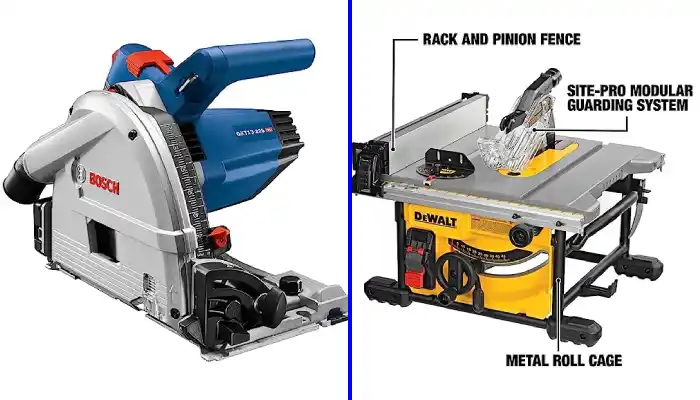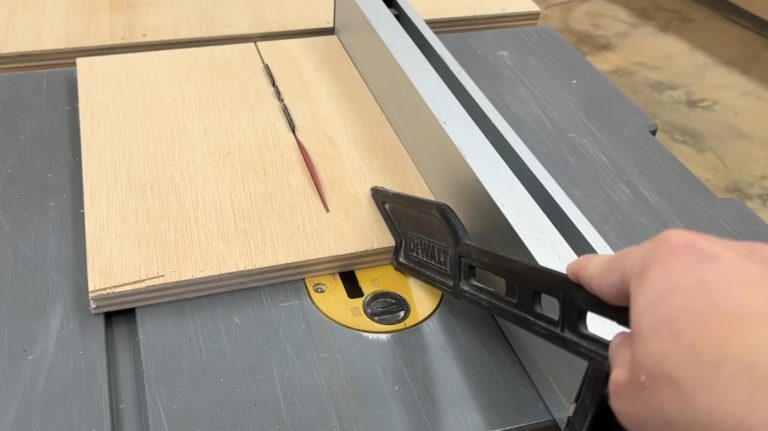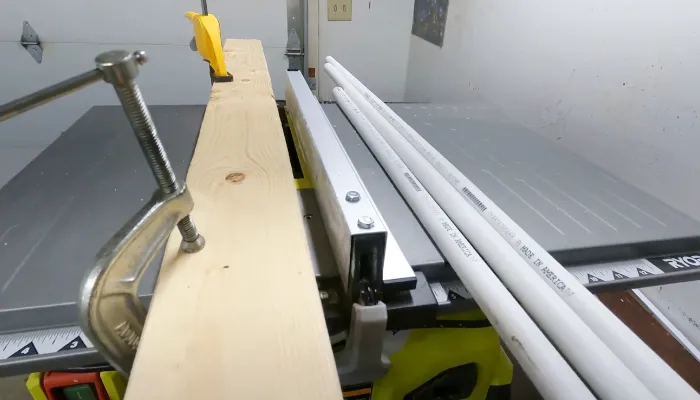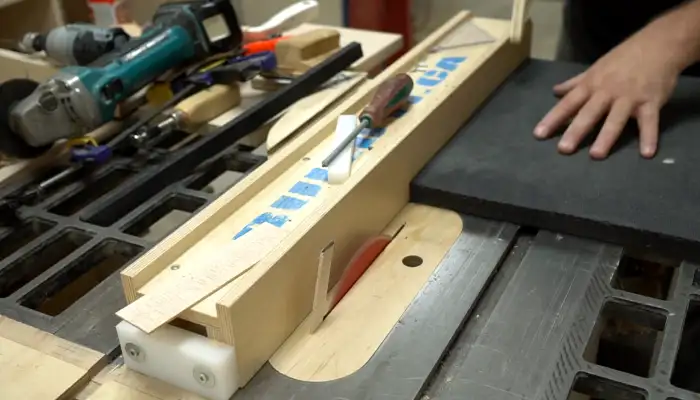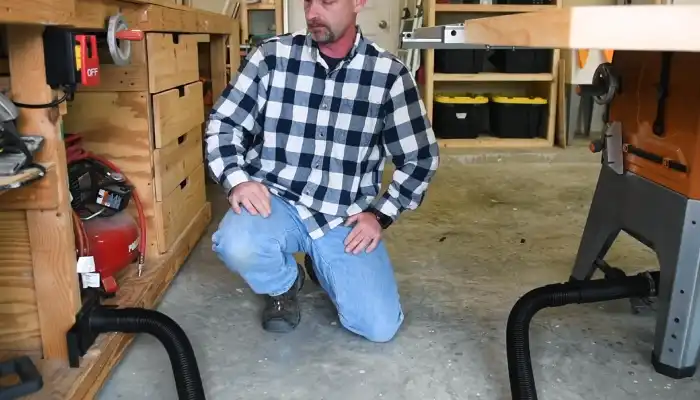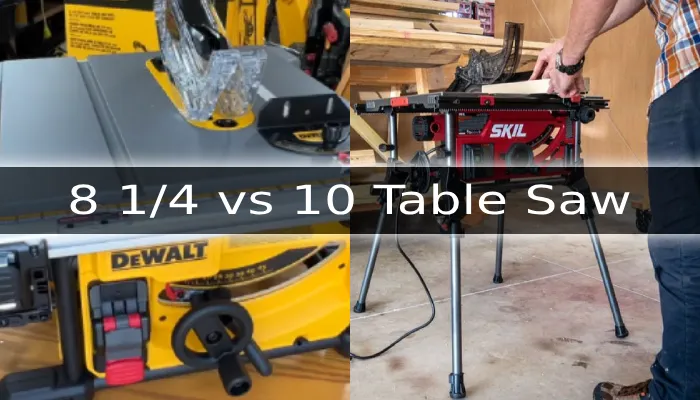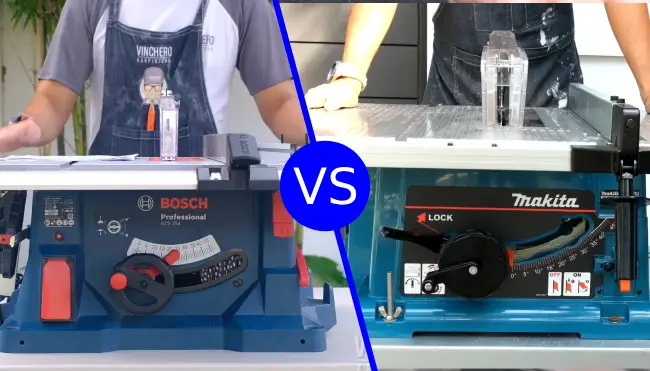Track Saw vs Table Saw: 10 Differences [Important]
Track saws and table saws are two of the most popular woodworking tools. While both saws have advantages and limitations, understanding their differences can help you make an informed decision.
The design of track saws makes them lightweight and easy to transport. In contrast, table saws are generally stationary and less portable due to their heavier and bulkier build.
In the table saws, you can cut four inches deep, while in the track saws, you can cut two to three inches deep. This makes table saws better suited for handling thicker materials.
Let’s examine the contrasts between these two saws so that you can choose the perfect one for your woodworking project.
- Rip boards and create plunge cuts up to 2.6 inches thick or 45-degree bevel cuts up to 1.85 inches…
- Variable speed operation goes anywhere from 2000 to 6000 RPM
- Accepts standard 7-1/4-inch miter and circular saw blades with 5/8-inch arbors
- Rack & Pinion Telescoping Fence System Make fence adjustments fast, smooth and accurate
- Patented material support, can be used for narrow rip cuts.
- 32-1/2″ rip capacity easily cuts a variety of larger shelving and trim materials
Track Saw vs Table Saw: In-Depth Differences
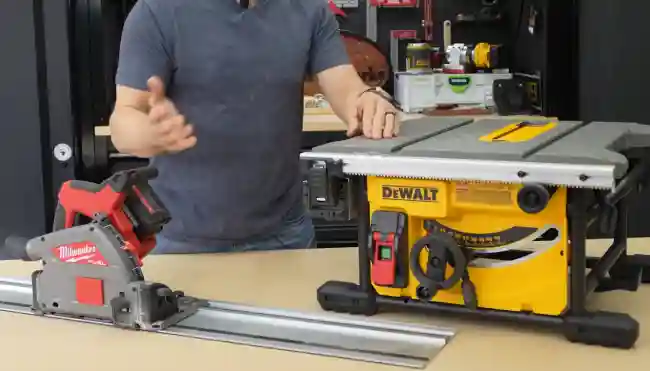
Choosing track saws or table saws can be difficult when cutting wood. Both offer unique advantages, but there are some key differences to consider. The following is a quick category of their differences.
1. Cutting Capacity
2. Portability
3. Price
4. Precision
5. Types of Cuts
6. Cutting Material
7. Consistency and Repeatability
8. Power
9. Dust Collection
10. Safety
Let’s examine these categories in more detail:
1. Cutting Capacity
Track saws are ideal for cutting sheet goods and thinner materials due to their limited cutting depth, generally ranging from 2 to 3 inches. Woodworkers prefer thin materials because they provide accurate and precise cuts.
The limited cutting depth of track saws doesn’t mean they lack power. They’re equipped with powerful motors that can easily cut through materials.
On the other hand, table saws have a greater maximum depth of cut, typically around 4 inches. With table saw, you can handling thicker materials, such as styrofoam and hardwoods more easily.
The increased cutting depth also allows for more versatile cutting options, including angled cuts and bevels.
With larger, more powerful motors, table saws can also handle epoxy resin composite cuts.
With their larger cutting capacity, table saws are the preferred choice for woodworkers who need to handle various materials and cutting tasks.
2. Portability
Track saws are a great option if you want a tool that’s easy to move around and take with you to different job sites or workshops.
They are designed to be lightweight and easily transportable, making them perfect for contractors or woodworkers who need to move from job site to job site.
Typically, track saws weigh half as much as table saws and come with carrying cases. In contrast, table saws are typically stationary and less portable. They are heavier and bulkier, making them less convenient to transport.
While some table saws may come with wheels or folding stands, they are still more challenging to move around than track saws. This makes them better suited for larger workshops or for woodworkers who can move their tools around less often.
3. Price
Track saws are generally more affordable than table saws, making them popular for DIY enthusiasts and professionals on a budget.
You can make straight and precise cuts on various materials, including sheet goods, without investing in a more expensive tool with a track saw.
The cost of a table saw can vary significantly, depending on the model and features. Some high-end table saws can cost thousands of dollars, which can be a significant investment for most users.
While track saws may not have the same capacity or features as table saws, they offer a cost-effective way to achieve accurate and efficient cuts.
4. Precision
Regarding precision between track and table saws, both tools can offer accurate cuts if used correctly. But, track saws may have an advantage in precision due to their design. Here are three reasons why:
- Controlled paths: Track saws operate on a track system that guides the blade along a straight path. This allows for consistent cuts parallel to the material’s edge.
On the other hand, table saws rely on the user’s ability to maintain a straight path, which can be difficult for beginners or those who need experience.
- Easy adjustments: Track saws have easy-to-use adjustments for blade depth and angle. This allows for precise cuts without constantly adjusting the blade or fence. Table saws may require more setup time to ensure accurate cuts.
- Splinter-free cuts: Track saws come equipped with a splinter guard that prevents tear-out on the bottom of the cut material.
This is especially useful when cutting expensive materials or when the cut edge will be visible in the final product. Table saws may require additional setup or accessories to achieve splinter-free cuts.
5. Types of Cuts
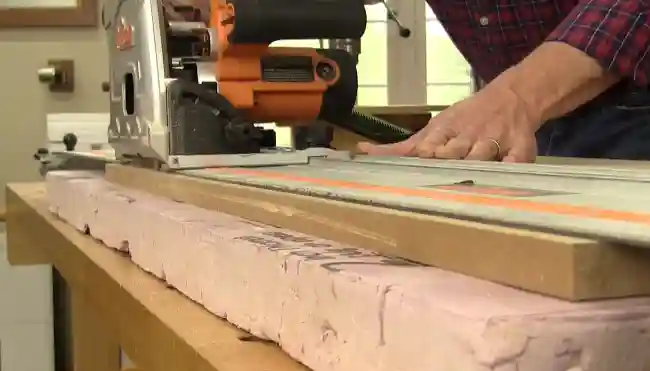
Table saws are great for making dado cuts, which are grooves cut into the surface of the wood. This type of cut is essential for creating joints, such as those used in cabinetry. Also, table saws can make an angle, miter, and bevel cuts. These cuts are useful for creating intricate designs and shapes in your woodwork.
On the other hand, track saws are versatile in making a cross, plunge, angular, miter, and rip cuts. One of the biggest advantages of a track saw is its ability to make long angled cuts across large materials, such as cutting panels. The saw’s guide rail allows for precise and accurate cuts.
Track saws also have the added benefit of being portable and easy to use. They can be taken to job sites and set up quickly, making them a great tool for professionals and DIY enthusiasts alike.
6. Cutting Material
Table saws are great for various woodworking tasks and can cut through many types of materials with precision. They are excellent for cutting thick stock, hardwood, and smaller pieces.
Meanwhile, track saws are mainly used for cutting sheet goods, such as plywood and MDF boards. These saws are perfect for handling large boards or sheets that might pose a challenge when using a table saw.
7. Consistency and Repeatability
Table saws offer the best consistency for repeated cuts, providing a stable and consistent setup that allows for precise and repeatable rip cuts on multiple boards.
This makes them ideal for projects that require uniform cuts, such as cabinetry, furniture manufacturing, and carpentry.
Conversely, track saws are more suitable for making one-off or custom cuts. While they can achieve accurate results, they may provide a different level of repeatability than table saws for identical cuts.
They’re perfect for projects like flooring, paneling, and doors that require a lot of customization and precision.
8. Power
Table saws are more powerful than track saws because they better handle larger wood pieces and thicker materials. Even though track saws can work with full sheets of material, it takes them longer and requires more effort to complete the same cutting task.
In essence, table saws are the go-to saws for heavy-duty woodworking projects, whereas track saws are better for lighter, less demanding jobs.
9. Dust Collection
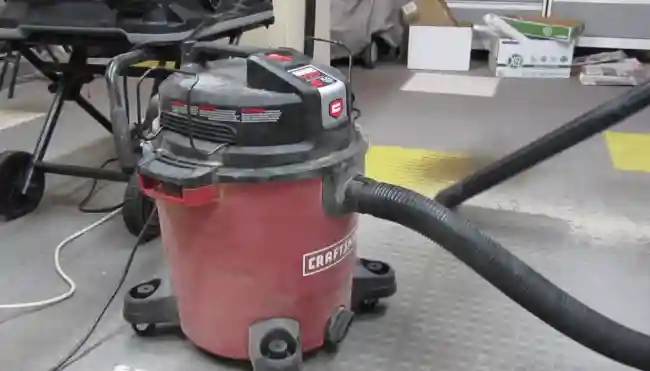
Table saws often come with integrated dust collection systems or attachments to help capture sawdust and keep your workspace cleaner. The effectiveness of these systems can vary depending on the model and brand of the saw.
Conversely, track saws almost always have built-in dust collection features that allow for effective dust extraction while cutting. This is because track saws are designed to be used in a more enclosed environment, where dust and debris can quickly become a hazard.
Therefore, these tools are equipped with advanced dust collection systems that keep your workspace clean and protect your health.
With a track saw, you can expect to have a cleaner and healthier working environment, which can make a big difference in your overall productivity and enjoyment of woodworking.
10. Safety
Table saws are known to be risky due to the exposed spinning blade. So, you must follow proper safety practices, such as using push sticks and guards, to minimize the risk of injury.
But track saws are a safer option compared to table saws. This is because track saws have a fully enclosed blade, which reduces the risk of accidental contact.
Also, the guided track provides increased stability and control during cutting, which enhances user safety.
Accidents can still occur, even with a track saw, so users must always exercise caution and remain alert while operating any power tool.
Comparison Chart Between Track Saw and Table Saw
| Feature | Track Saw | Table Saw |
| Cutting Capacity | Limited depth range (typically 2-3 inches) | Greater depth range (typically up to 4 inches) |
| Portability | Highly portable and lightweight | Less portable and bulkier |
| Precision | Accurate and easier to use, especially for beginners | Can achieve high precision with proper setup and techniques |
| Types of Cuts | Cross cuts, plunge cuts, angular cuts, miter cuts, rip cuts | Long cuts, angle cuts, miter cuts, bevel cuts, dado cuts |
| Cutting Material | Ideal for sheet goods and thinner materials | Suitable for a wide range of materials and thicknesses |
| Consistency and Repeatability | May have limitations in repeatable cuts | Excellent for consistent and repeatable cuts |
| Power | Less powerful compared to table saws | More powerful and capable of handling thicker materials |
| Dust Collection | Built-in dust collection features | Integrated dust collection systems or attachments |
| Safety | Safer to use with fully enclosed blade and guided track | Higher risk of injury due to exposed spinning blade |
| Depth Range | Limited depth range (around 2-3 inches) | Greater depth range (up to 4 inches) |
| Checking for Squareness | Need to check squareness of the track for 90-degree cuts | Generally set up to be square |
| Cutting Narrow Boards | Challenging to cut narrow boards | Excellent for ripping narrow boards with accuracy |
| Specialized Tasks | Limited for specialized tasks like splines or dadoes | Versatile for specialized tasks like joinery and dado cuts |
Can you use a track saw as a table saw?
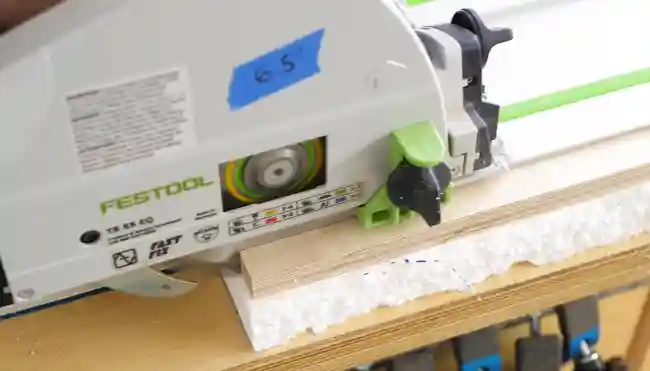
A track saw cannot be used as a direct replacement for a table saw due to its limitations in cutting depth and the inability to perform certain cuts, such as dado cuts.
While a track saw excels in cross cuts, rip cuts, and angled cuts, a table saw offers a flat table surface and a spinning blade that can handle thicker materials and provide precise and controlled cuts.
Track saws are valuable tools in their own right, but they should not be used in place of table saws when specific table saw functions and capabilities are required.
What can a table saw do that a track saw cannot?
A table saw has the ability to make deeper and narrower cuts, as well as dadoes and rabbets, which a track saw cannot do practically. Also, the standard setup or commonly available dado stack on a table saw excels at these specialized types of cuts.
This makes the table saw ideal for various woodworking projects that require precision and versatility.
Can you rip a 2×4 with a track saw?
It is possible to rip 2x4s with a track saw. Despite being commonly associated with cutting large sheet goods, track saws can also handle smaller dimensional lumber like a 2×4.
Ripping involves cutting material parallel to the grain, which can be achieved with a straight-edge guide or custom-made track. By aligning the track parallel to the desired cut line and setting cutting depth appropriately, you can guide the track saw along the track to make a clean and precise rip cut on a 2×4.
Track Saw vs Table Saw: Assess Your Needs and Find Your Perfect Match
The choice between a track and table saw comes down to personal preference. If you need a portable tool that allows for precise cuts on large sheets of material, then a track saw is a great option.
Contractors and DIY enthusiasts who work on-site will appreciate its ability to make straight cuts effortlessly.
On the other hand, a table saw is a versatile tool that can handle a wide range of cutting tasks, including thicker materials and angled cuts. But, it is less portable than a track saw and requires dedicated workshop space.
Ultimately, both tools have their unique advantages and limitations. The key is to assess your needs and decide which tool is the best fit for your projects. With the right saw, you can complete your cuts with ease and precision.
- The WEN track saw (CT1274) can make rip cuts up to 2.6 inches thick and 45-degree bevel cuts up to…
- It accepts standard 7-1/4-inch blades with 5/8-inch arbors and includes a 48-tooth carbide-tipped…
- The 110-inch track saw track guide rail is perfect for ripping 8-foot by 4-foot plywood sheets.
- RACK AND PINION FENCE RAILS – Ensures fence stays parallel to blade for fast smooth, and accurate…
- INTEGRATED FOLDING STAND – Legs quickly fold in to provide portability and convenient storage
- PARALLEL BLADE ALIGNMENT – Available micro-adjustment of blade so that it is parallel to rip fence…
Last update on 2026-01-07 / Affiliate links / Images from Amazon Product Advertising API

